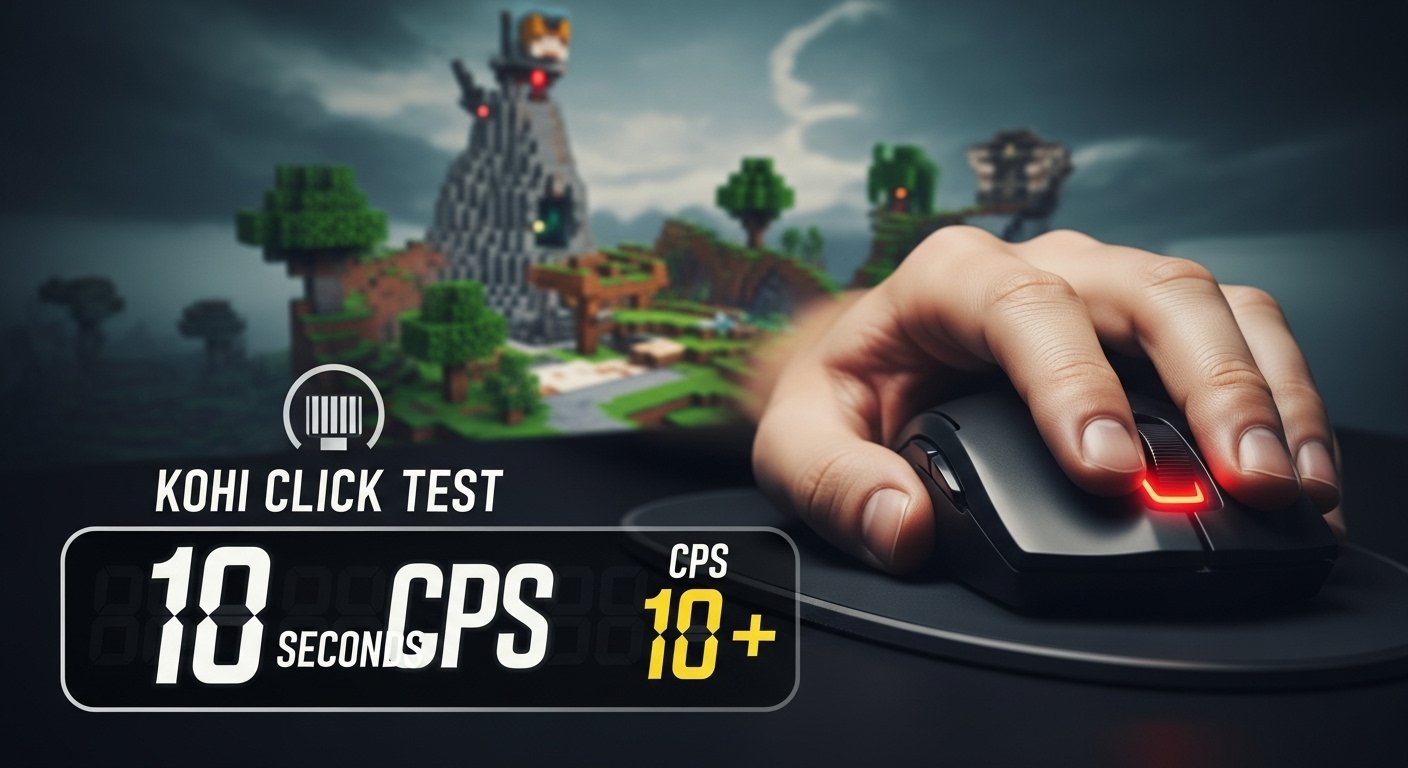For any player who was part of the golden age of competitive Minecraft, one name stands above all others as a benchmark of pure skill: Kohi. This wasn’t just a server; it was the ultimate proving ground. In this high-stakes world, your reputation lived and died by your mechanical ability, and one tool became the legendary yardstick used to measure a player’s raw speed and dexterity. This is the story of The Kohi Click Test, a simple online tool that became a piece of gaming history. This guide will explain exactly what it is, where it came from, and how a new generation of players can use this iconic test to benchmark their own skills against the legends of the past.
This is more than just a history lesson; it’s a practical guide to a timeless test of gaming performance. We will explore the unique style of Minecraft PvP that made this tool a necessity and correct the most common misconception about “Kohi clicking.” You will learn how to take the test, what your score means, and how you can use it as a training tool to genuinely improve your clicking speed. The first step on any journey of improvement is to know your starting point. Before we dive into the legend, we challenge you to take The Ultimate Kohi Click Test right now to get your baseline score. This is the number you’ll be trying to beat as you learn the techniques of the pros.
What is the Kohi Click Test, Really?
At its most basic, the Kohi Click Test is a simple, no-frills online tool designed to measure a player’s Clicks Per Second (CPS) over a 10-second period. It’s a sprint, not a marathon. Unlike other tests that offer various time limits, the Kohi test’s strict 10-second window became the community-accepted standard for proving you had the raw mechanical speed needed for high-level Minecraft PvP. It’s a pure benchmark of your finger dexterity and stamina.
The Simple Definition: A 10-Second CPS Benchmark
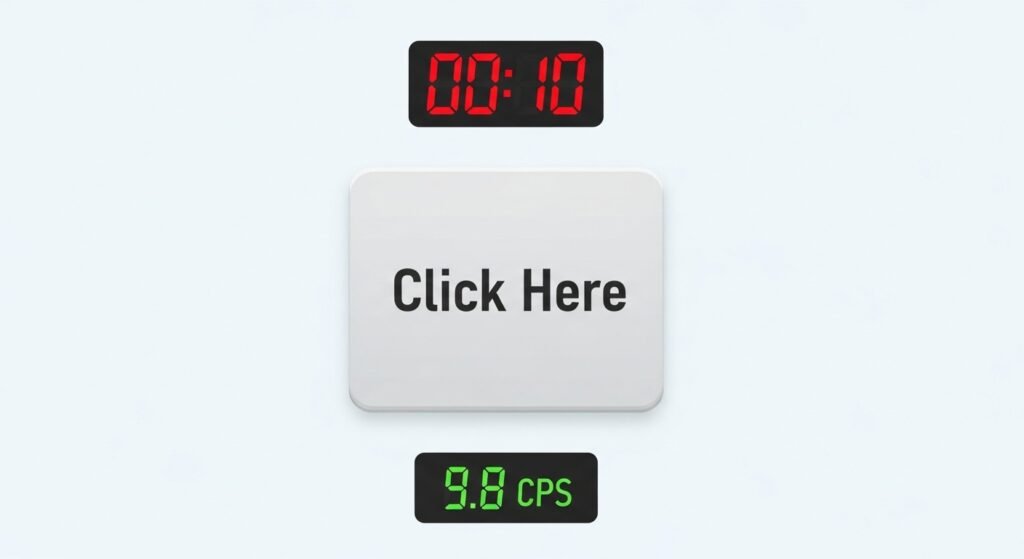
The test functions on a simple formula: it counts the total number of clicks you can achieve in 10 seconds and then divides that number by 10 to give you your average CPS score. For example, if you click 85 times, your score is 8.5 CPS. The goal for any aspiring player was to get this number as high as possible, as it was seen as a direct indicator of your potential in combat. This score became the universal language for click speed, a single number that could instantly communicate your skill level to other players. You can measure your own general speed with a standard CPS test to see how different time limits affect your score.
The Biggest Myth: Correcting the “Kohi Clicking” Misconception
This is the most important thing to understand: there is no such thing as a “Kohi clicking” technique. This is a common and widespread misunderstanding. The Kohi Click Test is the tool used to measure speed; it is not a method of clicking itself.
Think of it like this: A treadmill is a tool you use to measure your running speed. You wouldn’t say you are “treadmill running.” You are just running, and the treadmill is the benchmark. It’s the same here. Players use techniques like Jitter Clicking or Butterfly Clicking to achieve a high score on the Kohi test. The tool became so famous that its name was incorrectly attached to the skills it measured. So, when you hear someone mention “Kohi clicking,” what they really mean is using a high-speed clicking method to perform well on the Kohi Click Test.
A Personal Story: The Pressure of Trying to Hit “10 CPS” for the First Time
I’ll never forget the first time I heard about the Kohi test. I was new to a competitive Minecraft server, and in the chat, everyone was talking about their CPS. The magic number was 10. If you couldn’t hit 10 CPS, you weren’t considered a real threat. I felt this immense pressure to prove myself. I loaded up the test, my hand sweating a little. My first attempt was a clumsy 6.4 CPS. I was crushed. For the next hour, I did nothing but practice, trying to make my finger move faster. I could feel the burn in my forearm. Finally, after dozens of attempts, I saw it: 101 clicks. 10.1 CPS. The feeling of relief and accomplishment was incredible. It felt like I had just been accepted into an exclusive club. That small number represented a huge milestone in my journey as a competitive player, a common psychological phenomenon in gaming where players seek to meet community-set benchmarks, a topic often explored by gaming journalists at sites like Kotaku.
The Legend of Kohi: The Server That Birthed a Benchmark
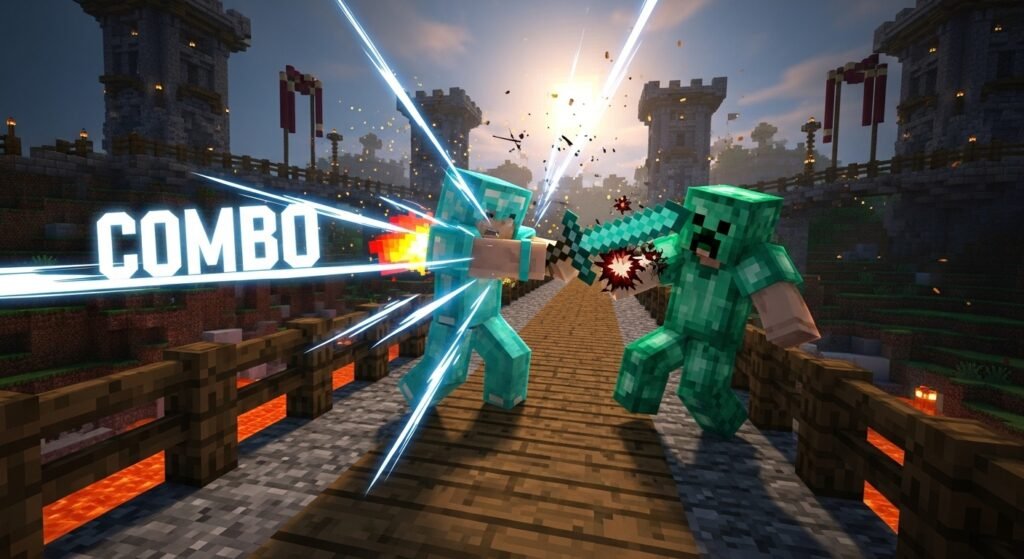
To understand why The Kohi Click Test became so iconic, you have to understand the place where it was born. This wasn’t just any tool from any server. It was the official benchmark of the most elite and competitive Minecraft PvP community of its time. Its legend is inseparable from the legend of the Kohi server itself.
What Was the Kohi Server? (A Look at Hard Core Factions PvP)
Kohi was a massively popular Minecraft server best known for its “Hard Core Factions” (HCF) game mode. This wasn’t your typical casual gameplay. HCF was a brutal, high-stakes, team-based survival experience. Players would form factions (or clans) and battle for dominance. The “Hard Core” part was serious: if you died, you were often banned from the server for a set amount of time, sometimes for days. This created an incredibly intense and competitive environment where every single fight mattered.
Why This Style of Combat Demanded Elite Click Speed
In the unforgiving world of Kohi, combat was direct and punishing. Unlike in other games with many special abilities and cooldowns, victory in Kohi PvP often came down to pure mechanical skill. The player who could land more hits per second had a massive advantage. A high CPS allowed you to:
- Create “Combos”: By hitting an opponent faster than they could hit you, you could lock them in a state of knockback, making them unable to fight back or escape.
- Out-damage Opponents: In a direct trade of blows, the faster clicker would almost always win.
This intense need for speed is what drove players to develop and perfect high-speed techniques. Players spent countless hours practicing methods like the one measured on the jitter click test, all to gain a tiny edge in the next battle.
How the Test Became the Community’s Gold Standard for Skill
Because click speed was so critical, the Kohi community needed a reliable way to measure it. The server developed its own simple, no-frills test, and because Kohi was the most respected place for serious PvP, its test became the gold standard.
A high score on The Kohi Click Test was more than just a number; it was a status symbol. It was your resume. Players would post screenshots of their scores to prove their worth, to get into powerful factions, or to intimidate their rivals. Before you fought a player, you wanted to know their CPS. It was a direct, unfiltered measure of their mechanical threat. This deep integration of a performance metric into a gaming community’s culture is a fascinating phenomenon, often explored in cultural retrospectives of gaming by publications like Polygon. The Kohi test wasn’t just a tool; it was the heart of a competitive legacy.
How to Take the Kohi Click Test: A Step-by-Step Guide
Taking the test is simple, but approaching it with the right mindset can make a big difference in your score. This isn’t just about randomly clicking; it’s about a focused, 10-second burst of maximum effort. Here’s how to do it right and understand your results.
Step 1: Finding an Accurate Recreation of the Tool
The original Kohi server is long gone, but its legacy lives on through countless online recreations of its famous test. The key is to find a version that is clean, responsive, and free from lag or distracting ads. You want a tool that accurately captures the simple, focused spirit of the original. For a reliable and authentic experience, you can use The Ultimate Kohi Click Test to measure your speed.
Step 2: Preparing for Your Test (The 10-Second Sprint)
This is a test of explosive speed. Prepare for it like a sprinter getting ready for a race.
- Get a Comfortable Grip: Place your hand on your mouse in the position you’ll use for your clicking technique. Make sure your arm and wrist are relaxed.
- Focus Your Mind: For these 10 seconds, your only goal is to click as fast and consistently as possible. Ignore everything else around you.
- Start and Go: Click the start button and immediately begin your clicking method. Maintain your maximum speed for the entire 10-second duration without slowing down.
Step 3: Understanding Your Score (What the Numbers Mean to a PvP Player)
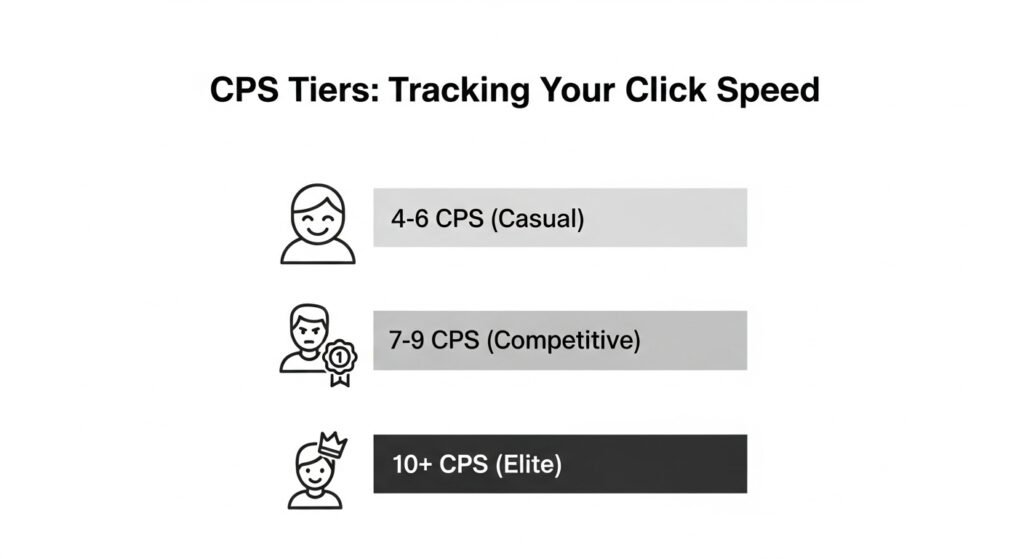
Your final CPS score is a snapshot of your mechanical skill. In the context of the Kohi PvP community, the numbers had very specific meanings:
- 4-6 CPS: An average, casual player. This is a normal clicking speed but would not be considered a threat in a competitive duel.
- 7-9 CPS: A competitive player. This is a solid, respectable score that shows you have fast fingers and can hold your own in a fight. Most serious players fall into this range.
- 10+ CPS: An elite player. Achieving a consistent score of 10 or higher was the mark of a true PvP pro. This is the speed required to perform devastating combos and was the benchmark that everyone aspired to reach.
The Techniques Measured by the Kohi Test
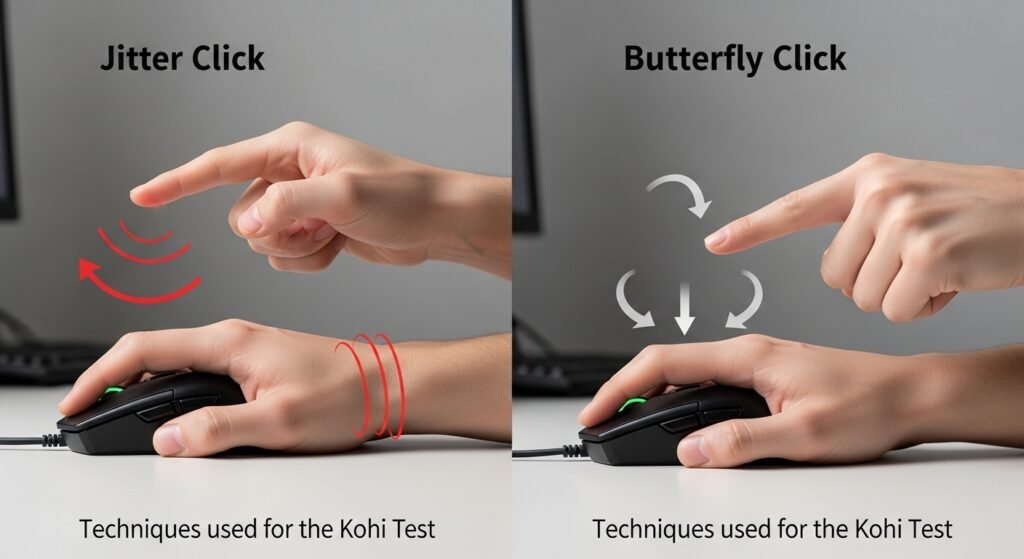
A high score on the Kohi Click Test is not achieved by normal clicking. It requires a specialized, high-performance technique that pushes your physical limits. The 10-second format is the perfect arena to test these skills, as it requires both explosive speed and enough stamina to maintain it. The two most famous methods used by top players to dominate the Kohi leaderboard are Jitter Clicking and Butterfly Clicking.
Jitter Clicking: The High-Stamina Vibration
This was one of the most popular techniques in the Kohi community. Jitter clicking involves tensing your arm and wrist muscles to create a rapid vibration, which is then channeled through your finger to the mouse button.
- Why it’s effective for the Kohi test: Jitter clicking is a high-stamina technique. While it might not always produce the absolute highest peak CPS, it allows a player to maintain a very fast and consistent click rate (often 10-14 CPS) for the entire 10-second duration without a significant drop-off. It’s a reliable workhorse method for this specific challenge. You can train your own consistency with a dedicated jitter click test for 30 seconds.
Butterfly Clicking: The Two-Finger Drum Roll
Another dominant method, butterfly clicking, involves using two fingers (index and middle) to rapidly alternate clicks on a single mouse button. This creates a drumming motion that can achieve an incredibly high CPS.
- Why it’s effective for the Kohi test: The butterfly method can produce a higher peak speed than jittering, often reaching 15-20+ CPS. It takes full advantage of mice that can “double click”—a hardware quirk where one press registers two inputs. You can see if your mouse has this quality by using the ultimate double-click test. The challenge of this method is maintaining the rhythm and control for the full 10 seconds.
Why the Test is About More Than Just Speed (Consistency is Key)
A one-second burst of speed is easy. The true challenge of The Kohi Click Test is maintaining that speed for 10 full seconds. Many players can hit a high peak CPS for a moment, but their speed quickly falls off as their muscles fatigue. The test’s graph of your performance is often more revealing than the final score. A flat, consistent line shows a player with excellent control and stamina. A line that starts high and then plummets shows a player who lacks consistency. This is why the Kohi test is such a respected benchmark: it rewards sustained performance, which is exactly what’s needed to win a real PvP duel.
The Kohi Training Loop: How to Genuinely Improve Your Score
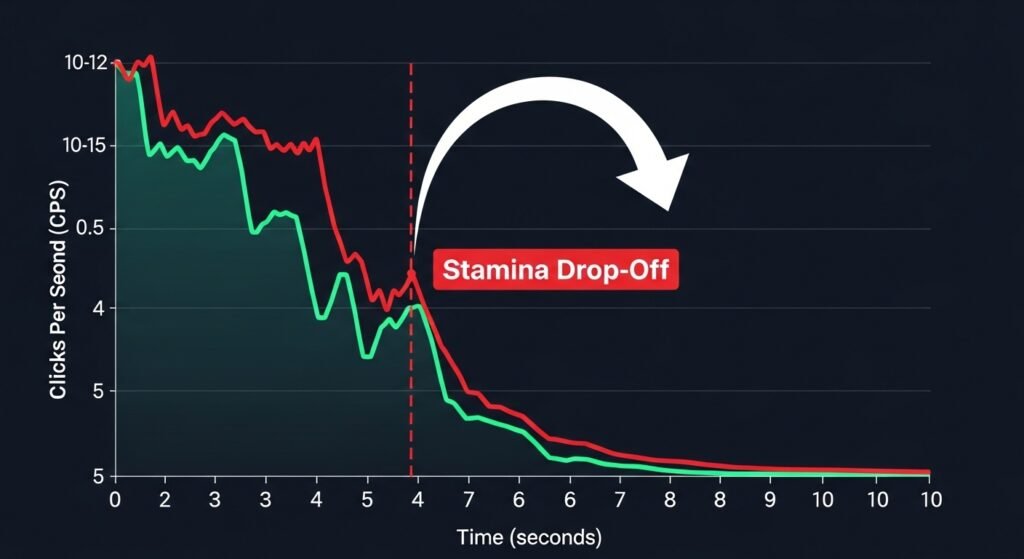
A high score on The Kohi Click Test doesn’t happen by accident. It’s the result of smart, consistent practice. Simply spamming the test over and over will only lead to fatigue. A true training plan is a loop: you test, analyze, practice, and then retest. Following this simple loop is the key to breaking through your plateaus and reaching elite speed.
Step 1: Establish Your Baseline Score
You cannot improve what you do not measure. Your very first step is to get an honest, “cold” score.
- Navigate to The Ultimate Kohi Click Test.
- Without any warm-up, take the test once.
- Write down your final CPS score.
This number is not a judgment; it’s just data. This is your official personal record, and your entire goal is now to make that number go up.
Step 2: Analyze Your Performance (Where Does Your Speed Drop Off?)
Your final score is only half the story. The most valuable piece of information from the test is the performance graph, which shows your CPS over time. Look at the shape of the line:
- Is it a flat line? This is excellent! It means your speed is consistent.
- Does it start high and then drop off a cliff after 5-6 seconds? This is the most common result. It indicates that your explosive speed is good, but your finger stamina is low.
- Is it shaky and inconsistent? This suggests your technique is not yet stable.
This analysis tells you exactly what you need to work on. If your stamina is the problem, you don’t need to practice going faster; you need to practice maintaining your current speed for longer.
Step 3: Use Specific Drills to Target Your Weakness
Now you practice, but you practice with a purpose. Based on your analysis, choose a drill:
- For Stamina: Instead of the 10-second Kohi test, use a longer test like a 30-second jitter click test. Your goal isn’t to set a new speed record but to maintain a consistent CPS without a major drop-off.
- For Consistency: Open a simple click counter without a timer. Practice your chosen clicking technique (Jitter or Butterfly) in short, controlled 5-second bursts, focusing on making the rhythm feel smooth and effortless.
Spend 5-10 minutes on these targeted drills. This is far more effective than just mindlessly retaking the main test.
Step 4: Retest and Track Your Progress
After your focused practice session, it’s time to re-enter the arena. Go back to The Kohi Click Test and give it one or two maximum-effort attempts. Compare your new score to your baseline. Did it improve? Is the graph looking more consistent?
Track your scores in a simple notebook or text file. Seeing that number climb over days and weeks is the ultimate motivation and provides clear proof that your hard work is paying off. This is the training loop that turns average players into legends.
Frequently Asked Questions (FAQ)
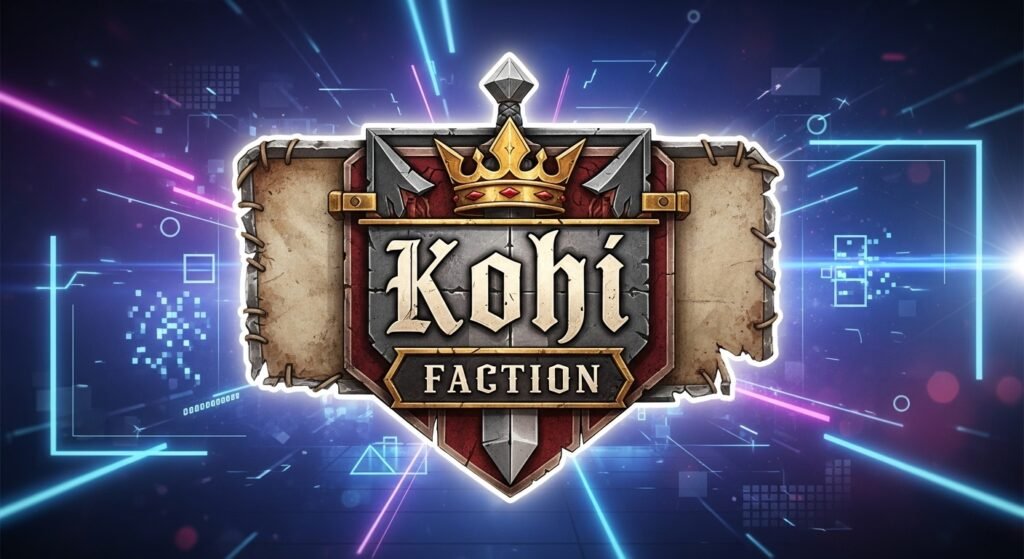
You’ve learned the history, the techniques, and how to train. But a few specific questions often come up about the legacy and specifics of The Kohi Click Test. Here are the direct answers.
What was considered a “pro” score on the original Kohi Click Test?
Why is the test 10 seconds long?
Is the Kohi Click Test still relevant for modern Minecraft?
Can you “fail” the Kohi Click Test?
Conclusion
You now know the full story. The Kohi Click Test is far more than a simple online tool; it’s a living piece of gaming history, a legendary benchmark born from one of the most competitive eras in Minecraft. It represents a time when pure, raw mechanical skill was king, and a 10-second sprint of your finger could define your reputation. You’ve learned the history, debunked the myths, and have a clear, actionable plan to test and improve your own skills against this iconic standard.
The legends of the Kohi server weren’t born with fast fingers; they were forged through endless hours of practice and a relentless desire to be the best. The same path is open to you. The ghost of that legendary server provides the ultimate challenge. So, go take the 10-second test right now, get your score, and begin your own journey. See how you stack up against the best of the best.
Which clicking technique will you use to try and beat the legends?

Hello, I’m John Harbour, a software developer passionate about creating innovative and accessible AI tools. As the creator of cps-checker.com, I enjoy building useful software and writing blogs to help people get the most out of my creations.

